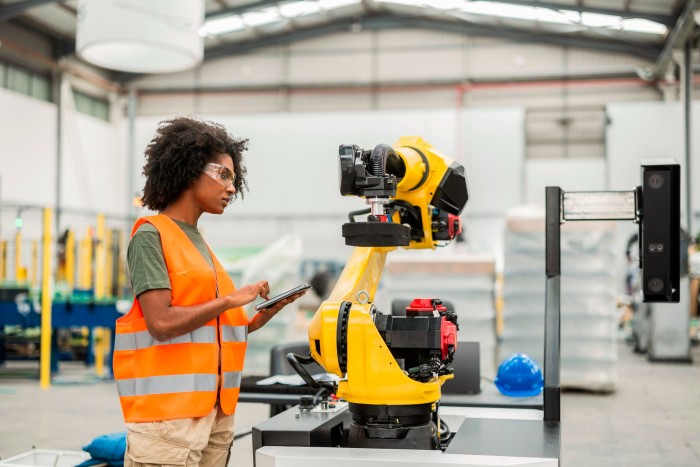Unlock the Editor’s Digest for free
Roula Khalaf, Editor of the FT, selects her favourite stories in this weekly newsletter.
Cobots, or “collaborative robots”, are a type of industrial robot designed to operate safely alongside human workers. Like conventional robots, they tend to take the form of a multi-jointed arm that can rotate, swivel, bend and contort to approach a job from any angle. Interchangeable tools at the end of their arms allow cobots to perform countless tasks, from assembling electronics and packaging pharmaceuticals to gluing and even welding. But the machines are smaller and more flexible than traditional robots, and are designed to be integrated with the workforce rather than separated from it, making automation attainable even for smaller companies.
How long have cobots been around and how big is the market?
The first cobot was invented in the mid-1990s by two professors from Northwestern University in Illinois, with the first commercial versions hitting the market a decade later. Since then the technology has surged in popularity as demand for automation soars in sectors from packaging to electronics, particularly among small and medium-sized enterprises.
Cobots accounted for 11 per cent of all industrial robots installed in 2023, the most recent year for which data is available, according to the International Federation of Robotics. The cobot industry now boasts sales of almost $3bn a year, according to California-based consultancy Grand View Research, which forecasts annual growth of more than 30 per cent to the end of the decade as adoption spreads.
Ben Morgan, interim chief executive of the Advanced Manufacturing Research Centre at the University of Sheffield, said that while cobots were “starting to come to the fore” around the start of the last decade, “now they’re far more commonplace — you see them in SMEs, you see them in multinationals, original equipment manufacturers, in lots of different applications”.
How do cobots differ from traditional industrial robots?
Robots have been used in heavy industry for decades, boosting productivity in sectors such as carmaking and metalworking. They tend to be large, expensive machines limited to a single task and their power requires them to be fenced off from workers to limit the possibility of injuries. The technical expertise required for their programming means deployment can carry the additional cost of hiring or contracting specialists, putting them out of reach for all but the largest of companies.
Cobots share their older siblings’ reliability and consistency but are smaller and tend to be far cheaper with a faster return on investment, allowing easy integration into existing workflows and lowering the barrier to automation. Typically worktop-mounted, they are equipped with sensors that halt their motion if a person or unexpected object gets in the way, allowing them to operate more safely alongside human colleagues without the need for costly safety caging. They do not always require specialist programmers. Many boast intuitive touchscreen technology or functions that allow a human operator to manipulate them, rather like a stop-motion animator, in a way the cobot learns and can then repeat. Such “plug and play” capabilities, combined with their portable size, makes them flexible — able to be switched to different tasks elsewhere on the production line.
“Cobots can help companies improve productivity, quality and consistency by introducing automation at lower effort, and with less disruption to the existing production line, than traditional robots,” said Susanne Bieller, general secretary of the IFR. Morgan of the AMRC said cobots provide smaller companies with a “soft entry” to robotics and automation.
How are cobots used?
The flexible nature of the technology has led to their adoption for a multitude of tasks. In the manufacturing industry, for example, cobots assemble products by manipulating their constituent parts together, fixing them with screws or glue, spraying them with paint, and even performing visual quality control. They are also ideal for “pack-and-place” warehouse tasks, picking up products and arranging them in boxes or pallets for storage or shipping without the risk of damage that human involvement can bring. Cobots are increasingly used in welding, a skill in decline in many markets, and in the plastics industry for tasks that are potentially hazardous for humans such as polishing and injection moulding. But the vast range of appendages to their arms means the possibilities are virtually endless.
Who are the biggest manufacturers?
Leading makers of cobots include Denmark’s Universal Robots, Japan’s Fanuc, ABB of Switzerland and Germany’s Kuka, which claims to have created the first commercial version of the technology. But surging demand has created “quite a crowded market”, according to Morgan, with a steady flow of new entrants.
Do cobots spell the end of skilled human labour?
Like industrial robots, cobots can work faster and with greater precision than people, raising the prospect that they could eventually replace the workforce. But advocates of automation say productivity gains help companies grow, which normally leads to larger rather than smaller workforces.
Morgan of the AMRC acknowledged that when robots or cobots are put into a factory, “it’s fair to say that the process they’re part of has less humans in it” — but he said displaced individuals were usually deployed in other parts of the business. He added that robotics “tends to help with the four ‘Ds’ — tasks that are difficult, dangerous, dull or dirty”, for which it can be difficult to hire workers.
